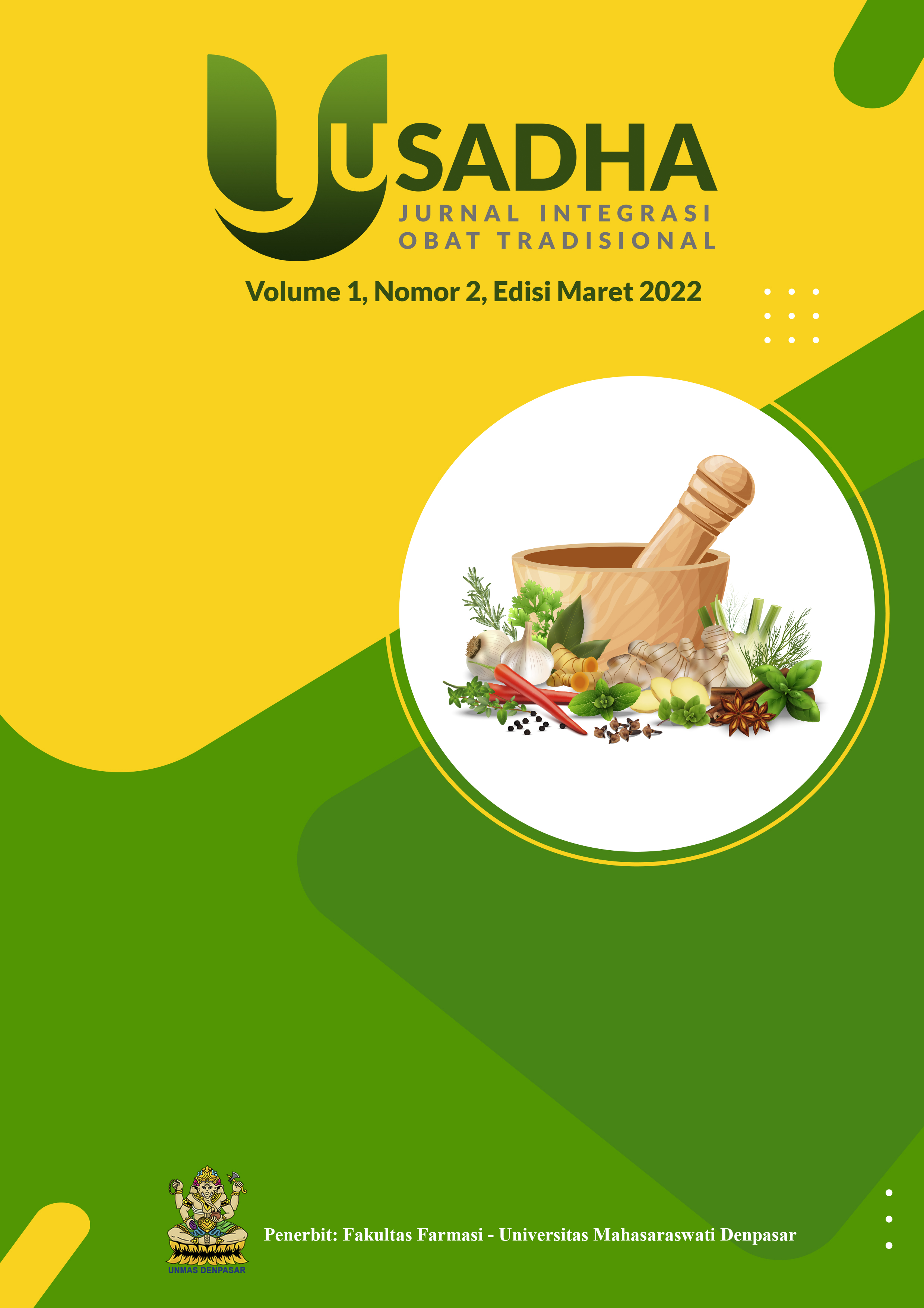OPTIMIZATION OF THE ANALGETIC EFFECTS OF BELUNTAS LEAF (Pluchea indica (L.) Less.) EXTRACT SYRUP ON WHITE MALE MICE (Mus musculus) WITH HEAT STIMULUS METHOD
Keywords:
analgesic, beluntas leaves extract syrup, heat stimulus methodAbstract
Beluntas plants generally grow wild in dry areas and have enormous benefits in treatment such as eliminating body odor, increasing appetite, overcoming pain and reducing fever. Beluntas leaves contain flavonoids which help the process of relieving pain. Pain is an uncomfortable sensory and emotional feeling related to (threatening) tissue damage. This study aimed to determine whether there is an analgesic effect of beluntas leaves extract syrup. This study was experimental using 25 mice which were divided into 5 groups. The negative control group was given aquades, positive control group was given paracetamol, and 3 experimental groups were given beluntas leaves extract syrup, each with a dose of 150mg/kgBB, 300 mg/kgBB, and 600mg/kgBB. Testting of analgesic effect was conducted by giving pain to test animals, in the form of hot stimulus with temperature of 550C. The response of the mice observed was the licking of the feet and or jumping. Observations were made for 1 minute. Observations were made before giving the test substance, and then successively in the 30, 60, 90, and 120 minutes after administration of the test substance. The results showed the number of responses to pain stimuli in the group of mice given beluntas leaves extract syrup began to decline in the 30 minute and continued to give effect in the 60 minute. In the 90th minute the analgesic effect began to decline, but it still showed the analgesic effect.At the second and third concentrations (300mg/kgBW : 600mg/kgBW) syrup of beluntas leaf extract (Pluchea indica (L.) Less.) had the best analgesic effect.
References
Dalimartha S. 1999. Atlas Tumbuhan Obat Indonesia Jilid 1, Penerbit Trubus Agriwidya, Jakarta.
Ardiansyah. 2005. Daun Beluntas Sebagai Bahan Antibakteri dan Antioksidan. http://www.beritaiptek.com.
Markham, K.R.1988. Cara Mengidentifikasi Flavonoid. Bandung: ITB.
Robinson, T. 1995. Kandungan Organik Tumbuhan Tinggi. Bandung : ITB.
Wilmana, P.F., dan Gan, S. 2007. Analgesik-Antipiretik, Analgesik Antiinflamasi Nonsteroid dan Obat Piral, dalam Ganiswara, S.G.,Setiabudy, R., Suyatna, F, D., Purwantyastuti, Nafrialdi, Farmakologi danTerapi, Edisi 5, Bagian Farmakologi, Fakultas Kedokteran, Universitas Indonesia, Jakarta.
Sibarani, V.R., M.W. Pemsi. dan A. Henoch. 2013. Ujianalgetika ekstrak daun beluntas (Pluchea indica L) pada mencit (Mus musculus). Jurnal e-Biomedik. 1(1): 621–628.
Wahyuningsih Sri S. dan`Linda Widyastuti. 2015. Uji Efek Analgetik Infusa Daun Beluntas (Pluchea indica L.) Pada Mencit Jantan Galur Swiss. Program Studi D III Farmasi, Politeknik Kesehatan Bhakti Mulia Sukoharjo. Jurnal Biologi Papua, 7 (2): 61-67.
Setyowati, W.A.E, dkk. 2014. Skrining Fitokimia dan Identifikasi Komponen Utama Ekstrak Metanol Kulit Durian (Durio zibethinus Murr.) Varietas Petruk. Jurnal Seminar Nasional Kimia dan Pendidikan Kimia VI. ISBN (979363175-0): 271-280.
Gunawan, S.G., Setiabudy, R., Nafrialdi, Elsyabeth, editor. 2008. Farmakologi
dan Terapi Edisi 5. Jakarta: FKUI.
Walsh, T.D. 1997, Kapita Selekta Penyakit dan Terapi, Hal 195–196, Penerbit EGC. Jakarta.
Tjay dan Tan Rahardja. 2007. Obat-obat Penting Khasiat dan Penggunaanya Edisi VI. Jakarta: Departemen Kesehatan Indonesia.
Marta, J.B. dan Jerzy, Z.N. 2014. Parasetamol: Mechanism of Action, Applications and Safety Concern. Journal of Acta Poloniae Pharmaceutica. 19:45-60.
Igantius, G.E., Zaraga, M.D., dan Ernest R. S. (2007). COXibs and Heart Disease, Journal of the American College of Cardiology. 49: 1-14.





